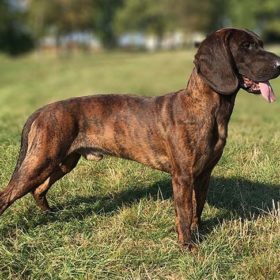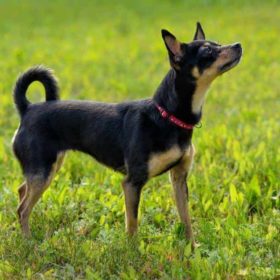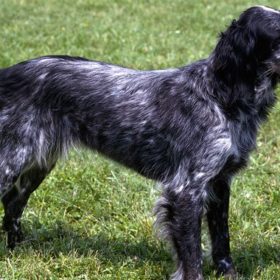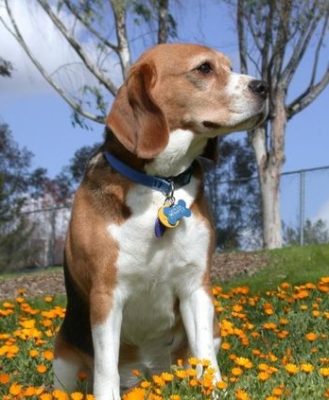Harrier

Many breeders claim that the hound has a similar temperament, even though not as famous as the beagle. The Harrier associates family members as its pack, so it becomes very quickly attached to anyone who spends enough time with it. The Harrier is considered the best breed for children. This dog is noted for its tolerance and excessive affection.
Table of Contents
Breed Information
| Another Name | – |
| Origin | United Kingdom |
| Height | Males 50-55 cm Females 48-50 cm |
| Weight | 22-25 kg |
| Fur | Short and thick |
| Color | Tri-color: mottled gray, black with feathers and blush |
| Lifespan | 10-12 years |
| FCI Classification | Scent hounds and related breeds |
| Group | Hunting dogs |
| Price | From $490 |
Breed Photos
Origin History
The history of the Harrier breed began in the south of England. The second name of the breed indicates the direct purpose of the hound – hare hunting. However, dogs are used for a wider purpose, such as hunting wild boar or fox. Exact information about the ancestors of the Harrier is lost. It is believed that the English hound became its close relatives.
During the Middle Ages, hunting became popular among the royal nobility. Dogs became an integral part of this activity. It explains such a variety of hounds. The Harrier is considered a unique dog with stamina and is large enough to accompany the horse with the hunter in the traditional version of the hunt.
Initially, the Harrier was much more numerous than the outwardly similar beagle. But then that changed, and even in its homeland, the Harrier ceased to have such popularity. The breed is purely a hunting breed, so it has not won a place in the show ring or as a companion.
Appearance
The head is long, the transition from forehead to muzzle is poorly expressed. The eyes are medium-sized, dark brown. The ears are flat. Strong body, the chest is deep. The back is muscular. The limbs are long and very strong. The tail is set high. The coat is short and thick, the color tricolor.
Character
Many breeders claim that the hound has a similar temperament, even though not as famous as the beagle. The Harrier associates family members as its pack, so it becomes very quickly attached to anyone who spends enough time with it. The Harrier is considered the best breed for children. This dog is noted for its tolerance and excessive affection.
Harrier does not show aggression towards strangers, except in the case of a potential threat. In the role of a guard, the hound cannot be considered because of its friendly nature. Such a dog will not cause discomfort to neighbors, always positive for any interaction. But the Harrier should not be left alone for long periods; the pet does not stand loneliness.
Harrier gets along well with other animals, especially dogs. Of course, it is important to introduce them from childhood.
If not enough time is devoted to training, the Harrier will behave very unpredictably. Despite its friendliness, at any moment, the dog may have a hunting instinct. By getting to know other animals in the street, uncontrollable situations can be avoided. It is worth remembering that the hound has power, which, if poorly trained, can cause harm to others.
The breed can be called stubborn. This quality is characteristic of many hounds because initially, they are aimed at a long chase and the final result. Therefore, it is necessary to devote a lot of time to training.
Harrier behaves quite calmly when he is at home and can sleep for hours. But this does not mean that the dog is lazy; it needs a lot of exercises every day. The hound is smart enough, quickly gets used to the daily routine, and will insist on a walk when its time comes. Such a way will not suit people with busy schedules. It is best not to have a breed whose conditions will not be properly maintained.
Unfortunately, the Harrier has a disadvantage. This breed can dig over an entire garden. It is necessary to monitor the dog’s behavior and immediately prohibit such habits. Also, the ringing bark of the Harrier is considered one of the most melodic. It is better to warn the neighbors about this feature right away so as not to cause unnecessary disturbance.
Care
The breed does not require special care. Hair should be combed out with a special brush; then, it will retain its natural shine. The dog sheds, so if you suffer from allergies, it is better not to consider the Harrier. Claws need to be trimmed several times a month. Frequent bathing of the dog is not recommended, but it depends individually on the walks. Eared breeds often suffer from dirt buildup. To avoid infection, their hygiene should be checked every few days.
Training
Training will be an important factor in shaping your dog. As soon as the puppy is at home, you should immediately introduce him to the territory and let him know who’s in charge. If the owner’s role shifts from one member to the next, no one will gain much authority. You can’t leave the doggie to himself. Persistent training should take place without punishment. Harrier loves edible rewards; they will be a good motivator.
Common Diseases
Harrier is characterized by exceptional health. But this does not reduce the risk of genetically inherited diseases. Check your dog’s ears and coat for parasites after every walk.
These are the diseases to which the Harrier is prone:
- dysplasia of the hip and elbow joints;
- dislocation of the kneecap;
- intervertebral hernia;
- glaucoma;
- cataract;
- ear infections;
- demodicosis;
- skin allergies;
- hypothyroidism.
Nutrition
Harrier puppies grow very fast, so the diet must be rich and varied. Portions can increase depending on the intensity of training and walks. Every day you should give a protein of animal origin, vegetables, porridges, and soups. It is better to take drinking water with you on a long walk.
 Russo-European Laika
Russo-European Laika Sealyham Terrier
Sealyham Terrier Pharaoh Hound
Pharaoh Hound Hanover Hound
Hanover Hound Russkiy Toy
Russkiy Toy Blue Picardy Spaniel
Blue Picardy Spaniel


